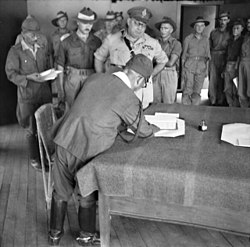British Military Administration of Borneo Borneo | |||||||||||||
|---|---|---|---|---|---|---|---|---|---|---|---|---|---|
| 1945–1946[1][2][3][4] | |||||||||||||
 Japanese forces surrender to Australians in Labuan on 1945. | |||||||||||||
| Status | Transitional government | ||||||||||||
| Capital | Victoria[5] | ||||||||||||
| Government | Military occupation | ||||||||||||
| Chief Civil Affairs Officer | |||||||||||||
• 1945–1946 | Brigadier Charles Macaskie | ||||||||||||
| Historical era | Post-war | ||||||||||||
| 15 August 1945 | |||||||||||||
• British Military Administration set up | 12 September 1945 | ||||||||||||
• Formation of the Crown Colony | 1 July 1946[1][2][3][4] | ||||||||||||
| Currency | British North Borneo dollar, Sarawak dollar | ||||||||||||
| |||||||||||||
| Today part of | Malaysia Brunei | ||||||||||||
| This article is part of a series on the |
| History of Brunei |
|---|
The British Military Administration (BMA) was the interim administrator of British Borneo between the end of the Second World War and the establishment of the Crown colonies of Sarawak and North Borneo in 1946. Specifically, the entity lasted from 12 September 1945 to 1 July 1946.[1][2][3][4] Labuan became the headquarters of BMA. The headquarters was mostly managed by the Australian Imperial Force (AIF).[5] The area under this administration today comprises Labuan, Sabah, Sarawak, and Brunei.[6] Sarawak was administered by Australians under British Borneo Civil Affairs Unit (BBCAU).[7]
- ^ a b "Sarawak as a British Crown Colony (1946 – 1963)". Sarawak State Government. Archived from the original on 4 August 2017. Retrieved 4 August 2017.
- ^ a b Walter Yust (1947). Ten eventful years: a record of events of the years preceding, including and following World War II, 1937 through 1946. Encyclopaedia Britannica. p. 382.
- ^ a b "History (British Military Administration in Borneo)". Chief Minister's Department. The Sabah State Archives. Archived from the original on 30 April 2014. Retrieved 1 May 2014.
- ^ a b Tamara Thiessen (2008). Borneo. Bradt Travel Guides. pp. 211–. ISBN 978-1-84162-252-1.
- ^ a b Ooi Keat Gin (7 June 2010). The A to Z of Malaysia. Scarecrow Press. pp. 60–. ISBN 978-1-4616-7199-2.
- ^ Stephen R. Evans (1990). Sabah (North Borneo): Under the Rising Sun Government. Tropical Press.
- ^ Ho, Hui Ling (2001). "Penyerahan Sarawak Kepada Kerajaan British, 1946-1951 (Cession of Sarawak to the British (1946 to 1951)" (PDF). Persatuan Sejarah Malaysia (Malaysian Historical Society). 9 (4): 43–73. Archived from the original (PDF) on 2017-05-17. Retrieved 14 March 2018.

